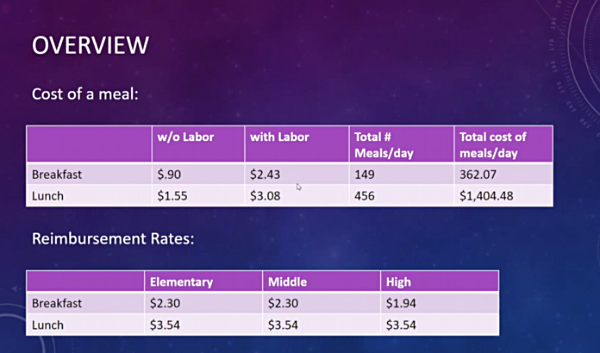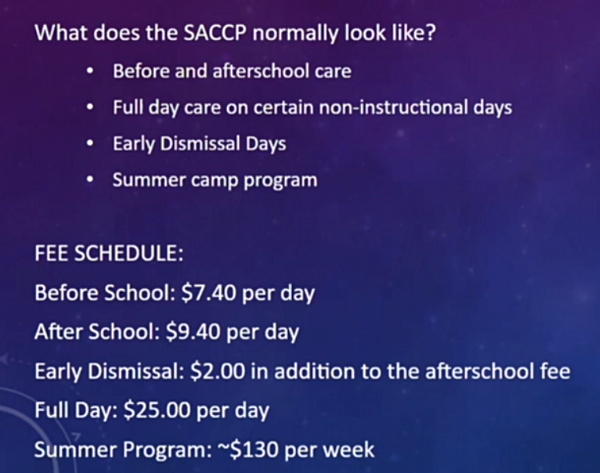- By Dan Veaner
- News
 Print
Print 
Superintendent Chris Pettograsso told the school board at its October 13 meeting that the Lansing Central School District is in good financial shape. But she warned that especially with the high level of uncertainty about state aid reduced because of COVID-19, that spending is an ongoing serious concern. While the general budget is in good shape at the moment, School Business Administrator Kate Heath reported that self-sustaining programs, including the school lunch program and the childcare program are suffering losses because of the impact of the pandemic.
"We are really lucky that we have such a strong program. Our typical expenses are payroll and benefits, the food and supplies such as utensils, napkins, office supplies, et cetera. Our typical revenues are from sales, which could be student meals, adult meals, a la carte items, which would be for example, ice cream or some of the snacks that they have in catering. And then of course there are the federal and state reimbursements," Heath explained.
Heath noted that Lansing is unique in that it doesn't have to supplement the meals program with money from the general fund. She gave a brief summary of what meals actually cost, plus an overview of what the District would gain or lose if all students enroll in the free lunbch program, as they are eligible to do because of state pandemic rules.
She noted that after applying reimbursements to actual meal costs, breakfasts are sold at a daily loss of $32.69, the gain of $209.76 from lunches on a typical day more than offsets that. $175 daily gain If all meals were paid she said there would be a daily loss of about $116. The majority of Lansing's meals are paid,
The overall impact of the pandemic on the meals program this school year is an unplanned loss of $32,000. Heath said that most expenses have remained, such as payroll, benefits, software, food purchases, and supplies. While there were some reduced expenses between March and June, there was no revenue from catering, a la carte items, and adult meal sales. But Heath reported that Swearingen had built up a healthy enough fund balance to sustain the loss, even with the planned spending.
 Chart from Lansing Central School District
Chart from Lansing Central School District"Where (Food Service Director Sandi Swearingen) makes money is in catering, the à la carte items, snacks, and adult meals. In March, most of that went away," Heath cautioned. "We had been required by the state education department and the child nutrition services to plan the use of that fund balance that she'd been building up. So we were buying new equipment. We were using it for this farm to school initiatives. And so we have that planed fund balance use. This last year we used significantly more than we planed to at $116,000 loss from revenue over expenses. So we're concerned moving forward."
School Board members noted that because the state has mandated that all students may receive free meals through the end of the current school year, and because of the reimursement advantage, that it will actually help Lansing's finances if students sign up for the free lunch program, even if they don't need to.
Heath said that the School Age Child Care Program (SACCP) is in more of a bind, because there are no extra funds to sustain a hefty fund balance, since revenues and costs are typically about the same. Expenses include payroll and benefits, supplies, and snacks for the children, most of which had to be spent even though the service couldn't be open during the lockdown.
"(Program Director Ron Frost's) revenue is all student based tuition. The majority of his expenses were still incurred during COVID, since the majority of those are payroll and benefits and we were having to pay for those, even though they weren't working, because of the Governor's (mandates). This last year the loss is $56,000. That's because he wasn't getting any tuition from March on, but he still had all those payrolls and benefits. He did have a fund balance of $41,000, so he was able to withstand some of that hit, but not the majority of it. What we're looking to do is see if we can mitigate that loss over the next couple of years. We're taking a hard look at tuition and the rates while trying to maintain those at a really reasonable level for our families. And then at some point we might have to look to see if we need to write those losses off through the General Fund. We're hoping not to have to do that -- typically that's not something we would ever look to do. Of course, this has been a year that obviously no one can plan for."
 Chart from Lansing Central School District
Chart from Lansing Central School DistrictHeath said that the net loss for the childcare program 2019-20 school year was $92,000, including a $75,000 loss of revenue, and the fund balance could not compensate for the entire loss. This year the proogram is on a different schedule, and fees have been adjusted. But she warned that the current schedule may change as Albany makes new mandates, and Frost can't estimate the number of staff needed or the number of students that will be served. Participation had been rising somewhat as the new school year began, but Heath noted it is leveling off now.
The Lansing District has had about a half million dollars in expenses directly related to COVID-19, including masks and other supplies, plastic barrirers, special signage, and so forth. Even though the district has evidently been able to sustain that hit, with the virus spiking again in many parts of the country, nothing is certain about how COVID will impact school districts in the future, especially where cuts to state aid are concerned.
"We've used our fund balance or our savings of sorts to help fund capital projects, to help fund the school years that have to keep our taxes lower," Pettograsso said. "And that is starting to diminish a little bit with these increased costs due to COVID and other things without any support. And then the uncertainty around the revenue -- we just don't know what state aid will look like throughout the year."
v16i42



